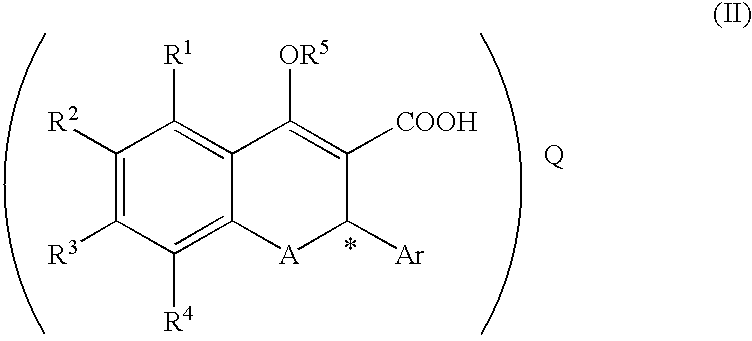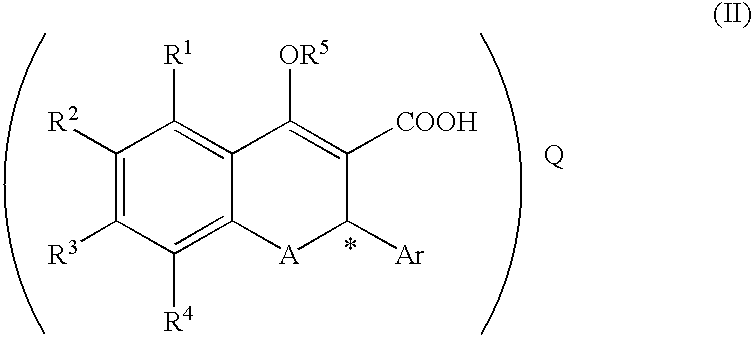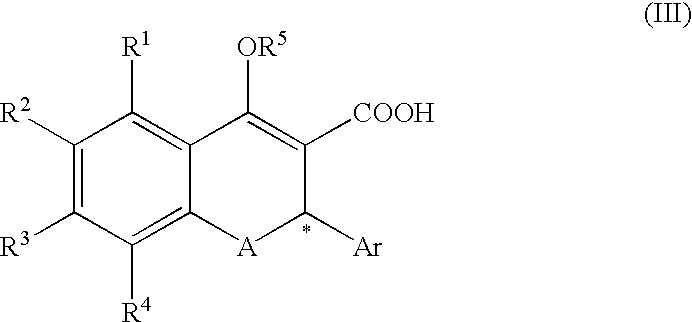Process for producing optically active chromene derivative
a chromene derivative and optically active technology, applied in chemical recycling, organic chemistry, etc., can solve the problems of ineffective optical resolution, inactive other, inability to achieve the effect of objective compound, etc., and achieve the effect of easy to obtain the objective compound
- Summary
- Abstract
- Description
- Claims
- Application Information
AI Technical Summary
Benefits of technology
Problems solved by technology
Method used
Image
Examples
example 1
(Step 1) Synthesis of Compound (II-1: R-Salt) from Compound (III-1: Racemate) ##STR16##
Compound (III-1: racemate) (327 g) was dissolved in ethyl acetate (3.27 L) and (1S, 2R)-(+)-norephedrine (129 g) was added to the solution. Seed crystals of Compound (II-1: R-salt) were added to the solution and the mixture was allowed to stand for 19 hours at room temperature. Then, the precipitates were filtered to isolate 217 g of crystals (R / S=94 / 6). In methanol (2.17 L), 217 g of the crystals was dissolved with heating for 10 minutes, then acetonitrile (2.17 L) was added thereto and methanol was concentrated. Acetonitrile (1.74 L) was added to the slurry of the concentrated solution. After acetonitrile (1.0 L) was added to the slurry again, the solution was concentrated, then the precipitates were filtered.
(II-1: R-salt) 184 g (40%) (R / S=100 / 0); .delta.H (d6-DMSO): 0.87(3H, d, J=6.6 Hz, amine-CH.sub.3), 1.21 (6H, d, J=6.2 Hz, CH.sub.3 X2), 3.25-3.36 (1H, m, amine-CH), 3.89 (3H, s, OCH.sub.3),...
example 2
Synthesis of (+)-2-(Benzo[1,3]dioxol-5-yl)-4-butyl-6-isopropyl-2H-chromen-3-carboxylic Acid (.alpha.-2)
Compound (.alpha.-2) was synthesized in the same manner as Example 1 Step 3 from Compound (I-1: R-acid) and n-butyl magnesium bromide.
mp 148-149.degree. C.; [.alpha.].sub.D.sup.22 +61.3 (c=1.00, MeOH) Calcd.for C.sub.24 H.sub.26 O.sub.6 : C, 70.23; H, 6.38 Found: C, 70.01; H, 6.43. .delta..sub.H (CDCl.sub.3): 0.98 (3H, t, J=7.20 Hz), 1.30 (3H, d, J=6.0 Hz), 1.31 (3H, d, J=6.0 Hz), 1.38-1.73 (4H, m), 2.92-3.22 (2H, m), 4.40 (1H, m), 5.89 (2H, s), 6.13 (1H, s), 6.66 (1H, d, J=7.8 Hz),J=7.8 Hz), 6.70-6.86 (4H, m), 6.96 (1H, d, J=2.2 Hz).
reference example 1
Recovery of (1S, 2R)-(+)-Norephedrine
The extracting operation in Example 2 Step 2 was carried out several times and 113 kg of the remaining aqueous layer was concentrated under reduced pressure to give 6240 g of (1S, 2R)-(+)-norephedrine phosphate. Into 25% aqueous solution of sodium hydroxide was poured 6240 g of the phosphate below 35.degree. C. over 40 minutes and the solution was stirred for 2 hours.
The slurry of the reaction solution was filtered and the obtained crystals of sodium phosphate were washed with 39 L of toluene. The obtained filtrate was separated to remove an aqueous layer, a toluene layer was dried over sodium sulfate, concentrated under reduced pressure, diluted with 4 L of hexane, crystallized and filtered to give 3567 g of (1S, 2R)-(+)-norephedrine as white crystals.
[.alpha.].sub.D.sup.22 +41.5 (c=5.0, N--HCl); mp 51.degree. C.; Calcd. for C.sub.9 H.sub.13 NO: C, 71.49; H, 8.67; N, 9.26. Found: C, 71.38; H, 8.65; N, 9.26.
PUM
 Login to View More
Login to View More Abstract
Description
Claims
Application Information
 Login to View More
Login to View More - R&D
- Intellectual Property
- Life Sciences
- Materials
- Tech Scout
- Unparalleled Data Quality
- Higher Quality Content
- 60% Fewer Hallucinations
Browse by: Latest US Patents, China's latest patents, Technical Efficacy Thesaurus, Application Domain, Technology Topic, Popular Technical Reports.
© 2025 PatSnap. All rights reserved.Legal|Privacy policy|Modern Slavery Act Transparency Statement|Sitemap|About US| Contact US: help@patsnap.com



